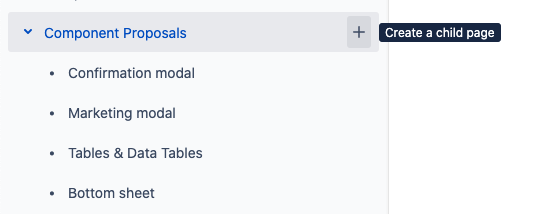HIGH-LEVEL FLOW
Collaborators:
Responsible | Flow | |
|---|---|---|
| 1 | Start a component proposal Identify new UI need and define the use case in a Google form submission or a Component Proposal. Bring it to the UI design team and #paragon-working-group to determine if it should be added to Paragon or a one-off solution. |
2 | Expand proposal into a component spec Share the spec with the #paragon-working-group | |
| 3 | Implement the component spec Publish the design, as well as UI, UX, and dev documentation. Request QA of the implementation. |
| 4 | QA the implementation |
| 5 | Finalize the implementation, UI UX doc, and dev (technical) doc Announce and celebrate! |
DETAILED FLOW
Step 1 – Start a component proposal
Responsible:  Accountable:
Accountable:  Consulted:
Consulted: 
 Informed:
Informed: 


If you need help creating a proposal submit a request (via Google form) to work with a designer.
If you need help creating a proposal submit a request (via Google form) to work with a UI designer.
Before starting a proposal confirm that the need is not already supported. Does a net-new pattern need creating? If there is an existing pattern, does it work for a specific application/use case?
Yes, it works (stop here if checked, and use an existing pattern)
No, it needs to get modified
Start a component proposal by creating a child page of “Component Proposals”
Use the Paragon Component template when creating the page.


The proposal should start as a . Work through the proposal states below to take your proposal from
to
to
.
State | Description |
|---|---|
The proposal is just an idea. Discussions on the draft serve to gather feedback and help prepare the idea to be | |
The proposal is ready for a review when it has:
Proposal Reviews start in person in the Paragon Working Group meeting and continue on Slack if needed. To get on the meeting agenda make a post in the #paragon-working-group channel on Slack. The group will consider the following:
Reviews can result in moving the proposal to | |
An accepted proposal is ready for design and engineering work. A proposal is accepted with three approvals (minus the proposer), one from each UX, UI, A11y, and Eng. Once accepted the proposer should begin building out the component spec with UX/UI/Eng/A11y (if they have not already). | |
A deferred proposal should be designed and built as a one-off where it is needed. Move the proposal to a new folder in this space (TODO: when this happens the first time add a folder in the wiki in an appropriate location) | |
A proposal needs changes to become |
- Once a proposal is APPROVED TO ADD, work to should proceed to create a component specification.
Step 2 – Create a component specification
Responsible:  Accountable:
Accountable:  Consulted:
Consulted: 

 Informed:
Informed: 
develops the proposal into a component specs, filling out the component proposal sections. This spec doubles as design documentation.
Share the component spec in the #paragon-working-group channel.
Step 3 – Implement the component specification
Responsible:  Accountable:
Accountable:  Consulted:
Consulted: 
 Informed:
Informed: 

Based on the design doc from the previous step:
: Implements the proposed design and creates dev doc
: Sends a link to the implementation for designer review
: Updates the design doc
Step 4 – QA the implementation
Responsible: 

 Accountable:
Accountable:  Consulted:
Consulted:  Informed:
Informed: 
QA: Identify bugs and design/implementation issues
Async: Use the #Paragon-working-group slack channel to review the implementation asynchronously
Sandbox (Adam has set up Paragon PR deployments)
Step 5 – Finalize the design and technical documentation & 
Responsible: 
 Accountable:
Accountable:  Consulted:
Consulted: 
 Informed:
Informed: 
Based on the QA findings from the previous step:
: Fixes bugs/design implementation issues, and ships
: Makes any needed updates to design spec for documentation, confirming with
and
Announce and evangelize the new design pattern throughout edX!
Share in Slack channels (which?)
Quarterly roll ups? Theme demos?
Have a drink or two (2 drinks per pattern)
See the RACI Matrix for detail on role definitions for Responsible, Accountable, Consulted, Informed.